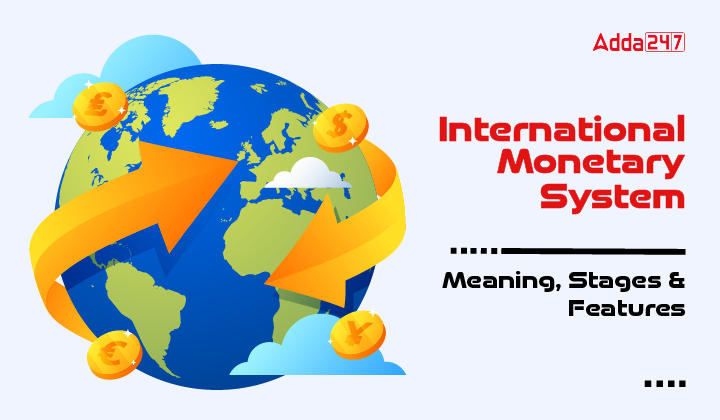Table of Contents
The International Monetary System is a framework governing financial interactions across national borders. It encompasses the rules, practices, and institutions that guide international transactions. In this article, we will discuss in detail the International Monetary System and its emergence over a period of time.
International Monetary System Overview
The International Monetary System serves as the backbone of the global economy, facilitating trade, investments, and financial stability. Its significance lies in its role as a regulator of cross-border economic transactions, ensuring that nations can exchange goods, services, and currencies with confidence.
International Monetary System Meaning
The International Monetary System can be defined as a set of arrangements, rules, practices, and institutions governing international transactions across national borders. It encompasses not only the issuance of international currency but also the interactions among the various currencies of individual nations, as well as the mechanisms for managing balance of payments relationships and their adjustments and settlements.
The International Monetary System involves overseeing three key processes:
- Balancing balance of payments positions, which includes establishing and modifying exchange rates.
- Addressing payment imbalances among countries through the utilization of credit or reserves.
- Providing international reserves (currency) to enable nations to manage temporary balance of payments deficits.
Aims of International Monetary System
The primary aims of the International Monetary System is to-
- The efficient and unrestricted flow of international investments.
- Stability in foreign exchange markets.
- Facilitating balance of payments adjustments to prevent disruptions.
- Supplying countries with adequate liquidity to handle the temporary balance of payments deficits without causing deflation or inflation.
- Minimizing additional uncertainty in the monetary system.
- Allowing member nations to pursue independent fiscal policies.
Stages in International Monetary System
The evolution of the International Monetary System can be categorized into five distinct stages that have played a pivotal role in shaping global financial dynamics. These stages reflect the dynamic nature of the International Monetary System and its continual adaptation to the changing global economic landscape. The five stages of the international monetary system are as follows:
- Bimetallism: Before 1875
- Classical Gold Standard: 1875-1914
- Interwar Period: 1915-1944
- Bretton Woods System: 1945-1972
- The Flexible Exchange Rate Regime: 1973-Present
Bimetallism: Before 1875
Bimetallism, prior to 1875, operated on a “dual standard” where both gold and silver served as currencies. Different countries adopted varying standards, with some opting for the gold standard, some for the silver standard, and some for both simultaneously.
Gold and silver were both employed as international mediums of exchange, and exchange rates between currencies were determined by their respective gold or silver contents.
Gresham’s Law
It is implied that the less valuable metal tended to circulate more widely. This economic principle asserts that when coins of differing metal values are considered legal tender with equal face values, people will preferentially use the coins made of the cheaper metal for transactions. Conversely, those made of the more valuable metal may be hoarded or exported, gradually disappearing from circulation.
Gresham’s Law, named in 1860 by Henry Dunning Macleod, was inspired by the insights of Sir Thomas Gresham, an English financier during the Tudor dynasty. However, it has roots in earlier expressions of the same concept, notably articulated by Nicolaus Copernicus, giving rise to its occasional designation as the Copernicus Law.
Classical Gold Standard: 1875-1914
During the Classic Gold Standard era, The relative value of currencies between the two countries was determined by the amount of gold they held in reserve. Hence in most major countries the following things happened:
- Gold held the exclusive privilege of being subject to unrestricted coinage.
- A two-way convertibility system existed, allowing gold to be exchanged for national currencies at a stable ratio, and vice versa.
- Gold could move freely across borders through export and import.
Operational Guidelines of Classic Gold Standard
- Each country established the worth of its currency based on the value of gold.
- Exchange rates between any two currencies were calculated as the value of one currency per ounce of gold compared to another currency per ounce of gold.
- These exchange rates were determined through arbitrage, taking into account the costs associated with transporting gold.
- Central banks were bound by restrictions preventing them from issuing more currency than their gold reserves allowed.
Consider a scenario where the U.S. dollar is fixed to gold at a rate of U.S. $30 for 1 ounce of gold, and the British pound is similarly pegged to gold at £6 for 1 ounce of gold. In this setup, the exchange rate between these two currencies is dictated by their relative gold content, following this calculation:
- $30 = £6
- $5 = £1
Under the Classical Gold Standard, the stability of exchange rates was exceptionally high, fostering a favourable environment for international trade and investment. Any misalignment in exchange rates or imbalances in international payments were automatically rectified by a mechanism known as the price-specie-flow mechanism.
Price-Specie-Flow Mechanism
Suppose Great Britain exported more goods to France than France imported from Great Britain. This trade surplus would result in a net flow of gold from France to Great Britain. As gold flowed from France to Great Britain, it would lead to a decrease in the price level in France and, simultaneously, an increase in the price level in Britain. These shifts in relative price levels would then discourage exports from Great Britain while encouraging exports from France, helping to correct trade imbalances.
Supporters of the Gold Standard cited its benefits, such as price stability and automatic balance of payments adjustments. Critics, however, highlighted concerns like the reliance on gold production, gold supply volatility, practical constraints on monetary authorities, and limitations on monetary policy.
Interwar Period: 1915-1944
Exchange rates experienced volatility as countries extensively employed currency devaluations, often seen as aggressive actions aimed at gaining an edge in the global export market. Efforts were undertaken to reinstate the gold standard, but the participants lacked the political determination to adhere to the established rules. The global economy was marked by significant instability, eventually resulting in a severe economic breakdown recognized as the Great Depression (1930-1939).
International Economic Disintegration
- It was widespread during the Great Depression, affecting numerous countries.
- The imposition of restrictions on international trade and payments inflicted substantial economic damage, as these “beggar-thy-neighbour” policies prompted retaliatory actions from foreign nations, ultimately contributing to the disintegration of the world economy.
- It’s worth noting that all countries had the potential to improve their circumstances through international cooperation, a concept that materialized in the form of the Bretton Woods agreement.
Bretton Woods System: 1945-1972
The Bretton Woods System, named after a 1944 meeting in Bretton Woods, New Hampshire, aimed to create a post-World War II International Monetary System. Its goal was to achieve exchange rate stability without the gold standard.
Key Outcomes of Bretton Woods System
- International Monetary Fund: Established to maintain order in the global monetary system.
- World Bank: Created to promote general economic development worldwide.
Key Features Bretton Woods System
- Under Bretton Woods, the U.S. dollar was pegged to gold at $35 per ounce, and other currencies tied their values to the dollar.
- Countries had to keep their exchange rates within ±1% of their chosen par value.
- This system operated as a dollar-based gold exchange standard.
Demise of the Bretton Woods System
- In the post-war period, the U.S. provided dollar reserves for currency market interventions, leading to doubts about the dollar’s gold backing.
- Foreign-held U.S. dollars increased, raising questions about the U.S.’ ability to exchange dollars for gold.
- Domestic policies, including Vietnam War expenses, led to more dollar printing and forced foreign governments to amass dollar reserves.
- During the 1960s, the U.S. dollar was seen as overvalued globally.
- In 1971, President Nixon closed the gold window, ending dollar convertibility into gold.
- By 1973, the world sought a new financial system free from fixed exchange rates.
The Flexible Exchange Rate Regime 1973-Present
- The IMF members accepted the use of flexible exchange rates.
- Central banks gained the authority to intervene in currency markets to address unwarranted volatility.
- The international community moved away from using gold as a reserve asset, and currencies were no longer backed by gold.
Regarding Current Exchange Rate Arrangements
- Free Float: Approximately 48 countries allow market forces to determine their currency’s value.
- Managed Float: About 25 countries blend government intervention with market dynamics to establish exchange rates.
- Pegged to Another Currency: Some countries peg their currency to another, such as the U.S. dollar or another currency.
- Absence of a National Currency: Certain nations, like Ecuador and Panama, opt not to issue their own currency, instead using the U.S. dollar; this is known as dollarization.
Conclusion
The International Monetary System has witnessed significant transformations throughout history. From the days of bimetallism to the era of flexible exchange rates, each phase has brought its own set of challenges and opportunities for the global economy. As we move forward in a world characterized by dynamic economic interactions, the International Monetary System will continue to evolve.
Download UGC NET Commerce Study Notes PDF
The direct Link to Download UGC NET Commerce Study Notes PDF has been mentioned below. Candidate can download International Monetary System Study Notes PDF which has been mentioned below.
Download International Monetary System Study Notes PDF



 UGC NET Commerce Syllabus 2025 PDF Downl...
UGC NET Commerce Syllabus 2025 PDF Downl...
 UGC NET Teaching Aptitude Questions Answ...
UGC NET Teaching Aptitude Questions Answ...
 UGC NET Philosophy Syllabus 2025 PDF Dow...
UGC NET Philosophy Syllabus 2025 PDF Dow...




